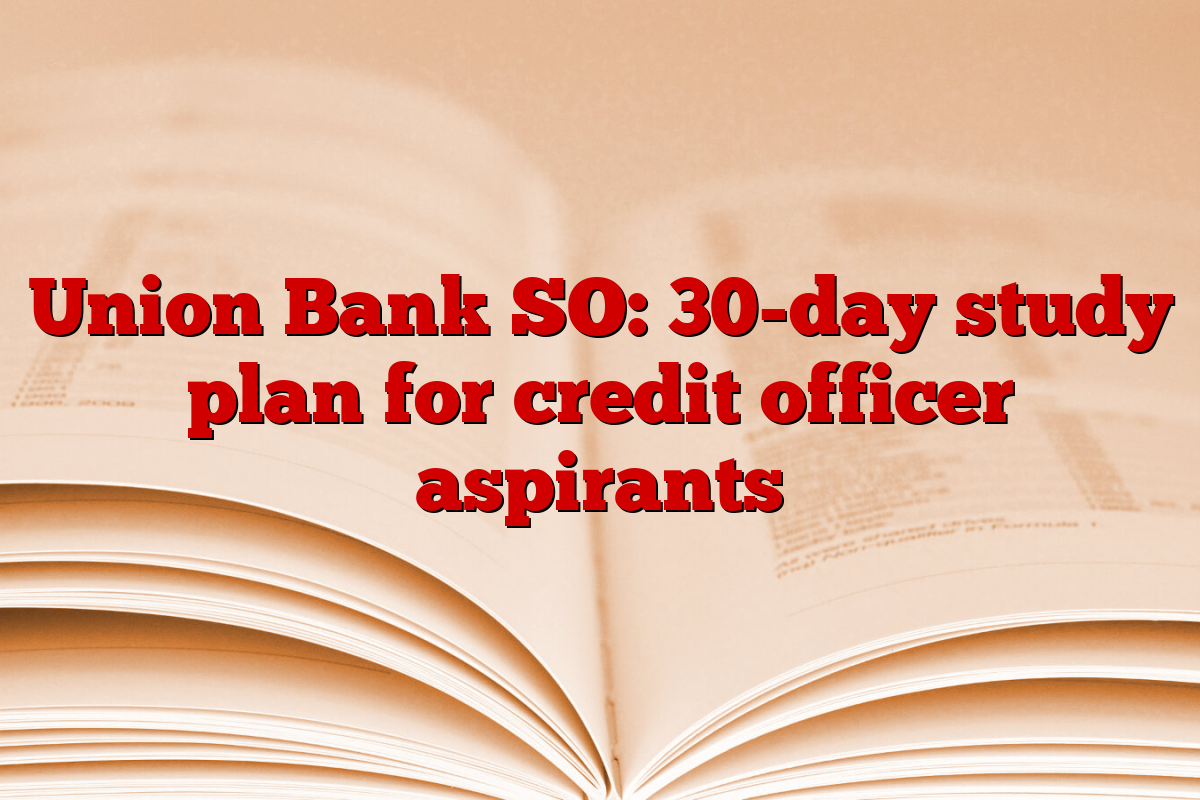The Union Bank of India conducts the recruitment examination to appoint officers and other expert roles. Credit Officer Post is one of the most popular and important positions. If you have only 30 days left for the exam, don’t worry. With a concentrated study plan and coherent practice, you can cover all major topics and improve your success prospects. This article gives you a clear and practical 30-day study plan that covers all subjects including professional knowledge, logic, quantitative ability and English language.
Union Bank SO: 30-day study plan for credit officer aspirants
Before starting your preparation, it is important to understand how the paper is set. Union Bank SO Credit Officer Exam usually includes four main section logic, quantitative qualifications, English language and professional knowledge. Each section consists of multi-passe questions, and may have negative marking for wrong answers. Among all classes, professional knowledge is most important because it tests your domain expertise and carries more weight in overall selection. Therefore, while all sections are important, you should pay special attention to the professional knowledge part related to credit evaluation, debt processing and financial analysis.
Week 1: Create Basics
Day 1 to 3:
Start your preparation by creating a strong foundation. For logic, start with basic subjects such as puzzles, seating arrangements, blood relations and direction feelings. These subjects are common in most banking examinations and can be scored well with practice. At the same time, start quantitative qualifications by modifying basic arithmetic concepts such as percentage, ratio, simplification and average. These topics will help you to solve more complex calculations later.
In professional knowledge, start learning by learning the structure of Indian banking, types of credit features provided by banks and basics of credit risk. Study different types of loans such as term loan, working capital loan and overdraft. Try to understand how the credit of a borrower is judged.
Day 4 to 7:
Now proceed on slightly advanced logic subjects like sylogism, inequality and coding-decoding. These questions often appear from medium to hard levels. In volume, continue with profit and loss, simple and compound interest, and time and work.
For professional knowledge, start studying working capital management. Learn how banks calculate the needs of working capital of a business. In addition, focus on the credit assessment process, documents required for debt processing, and learn how to read basic financial statements such as balance sheet and profit and loss account. Understanding these will help you answer practical questions related to loan and loan.
Week 2: Strengthen core areas
Day 8 to 10:
At this stage, you should start solving the mixed argument set to improve your speed and accuracy. Continue modifying the previous subjects and focus on data interpretation (DI) in the volume of DI as DI is an important field in banking examinations. Practice pie chart, bar graph and table.
In professional knowledge, study subjects such as financial ratio are used to assess credit. Learn to calculate and interpret the current ratio, loan-equity ratio, interest coverage ratio and others. Also how non-performing assets (NPAs), basal norms and bank credit risk manage. These subjects are often tested through landscape-based or case study questions.
Day 11 to 14:
Pay attention to modification and practice. Try fake questions in both logic and quantity. For English, start with reading understanding, close tests and sentences to be re -preferably. The vocabulary manufacturing and grammar modification will also help score well.
In professional knowledge, the study type of borrowers, debt documentation and risk evaluation. Know how banks assess the risk when approved the loan and what measures they take to reduce the lapse. It will help you during the interview after cleaning the written examination.
Week 3: Practice and Amendment
Day 15 to 17:
Now this is the time to start every alternative day full-lengthy fake testing attempts. These tests will help you check your preparation level and identify weak areas. Modify concepts such as RBI’s borrowed guidelines, sectoral exposure limits and risk rating models pay special attention to your professional knowledge preparation. Understanding these regulatory criteria is very important for the role of a credit officer.
In addition, start reading financial newspapers or banking magazines to stay updated with current events. This will help in English preparation and will also make you understand the real world of credit-related issues.
Day 18 to 21:
By now, you should have completed almost all important subjects. Use this stage for mock test analysis. Just don’t solve the tests and go back where you went wrong and modify those concepts. Practice error spotting, filling spaces, and phrase replacement in English.
In professional knowledge, if available, the credit officer should solve the previous year’s questions. In addition, go through case studies that require decisions and decision -making skills. Learn how a credit officer assesses a loan application, whether documents are checked, and how are the decisions taken.
Week 4: Final Touch and Full-Lambai Practice
Day 22 to 25:
This is the last stretch. Now you have to try a mock test daily in situations like exam. Pay more attention to speed and time management. After each test, modify important mistakes and weak areas.
In professional knowledge, go through your small notes and revise major concepts such as rating of camels, credit approval process, loan monitoring and debt recovery. They are likely to be asked in the exam.
Day 26 to 30:
In the last 5 days, avoid learning new topics. Only focus on modification and mock test reviews. Maintain a notebook of frequently asked questions and go through them daily. Relax your mind and avoid stress. Take care of your health, sleep well, and be inspired.
